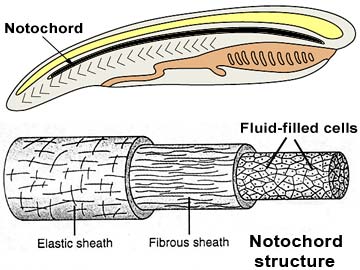We already discussed what is Chordata and their diversity in the animal kingdom and now we are going to discuss the characteristics features that separate Chordata from other groups of animals.
All the members of phylum Chordata show three fundamental characteristics in their lifecycle at least at a point of their lifecycle but it is not necessary that we can see all the three features in their lifecycle at any stage.
The three fundamental morphological features are – dorsal tubular hollow nerve cord, a “string”, “cord” or “rod” like supportive structure notochord, and pharyngeal gill slits.
We can say any animals to be Chordata if we find the above-mentioned three morphological features in any stage of their life cycle, now we will discuss all the features one by one.

Dorsal Hollow Nerve Chord or Neural Tube:
On the dorsal side, a hollow tube-like structure is present in phylum Chordata and it is made of nervous tissue which forms the central nervous system in Chordata.
During embryonic development, the ectodermal neural plate forms this tube-like structure which is present throughout the length of the body longitudinally and it encloses a tubular hollow cavity which is known as neurocoel.
A nerve chord is also known as a neural tube that presents just above the notochord and it performs the neural coordination in the whole body, acts as the central nervous system.
In vertebrate, the central nervous system we see is actually the advanced form of the dorsal hollow nerve cord, in vertebrate the anterior part of nerve cord form enlarged brain covered by brainbox or cranium while the remaining part of nerve cord forms spinal cord which presents in the vertebral column.
Notochord:
It is the main feature of the members of phylum Chordata and the name Chordata is also due to the presence of notochord in Chordata. The Chordata comes from the Latin word “chorda” which means cord or string-like structure and in lower Chordata, the notochord looks like a rod or string or chord-like structure.

It presents just below the nerve chord and provides mechanical support to the other parts of the chordate body. During embryonic development endoderm of the archenteron give rise to a special type of large vacuolated cell notochordal cells which form the notochord.
The notochord is a flexible supportive endoskeletal structure that forms a vertebral column in the vertebrate and encloses the nerve chord to give protection.
Pharyngeal Gill Slits:
In Chordata lifecycle show slits on the pharyngeal wall on the lateral side and they present in pairs but the gill slits do not persist throughout their whole life. In most of the aquatic Chordata, gill slits play a very important role but in terrestrial Chordata pharyngeal gill slits are only present at a certain phase of their embryonic development, in the adult stage, they do show pharyngeal gill slits.
In fish the pharyngeal gill slits have gill which helps in respiration, in lower aquatic Chordata pharyngeal gill slits help in filter-feeding, through the pharyngeal gill slits water passes and the chord can trap the food from the passing water.

In most of the advanced Chordata, the adult stage does not show pharyngeal gill slits, as in the case of a frog during the tadpole stage pharyngeal gill slits contain gills which helps them in respiration but when they become adult their lungs become functional, and pharyngeal gill slits become useless and in fully adult frog gill slits are absent.
In very rare cases we can see all the three chordate features throughout the life, in most of the case all the three chordate features only present in early stages of their embryonic development.
In higher Chordata, those three features are either modified to advance form or sometimes lost completely, as in the case of vertebrate notochord replaced by the vertebral column and nerve cord is replaced by the enlarged brain and spinal cord while pharyngeal gill slits are lost completely.
Reference: Phylum Chordata 3 Fundamental Character
Hi Everyone!!! Welcome to Imaluop. Imaluop always try to learn some new and he want to share to other people. Here we will try to learn various topics on Science, specially on Biological Sciences.